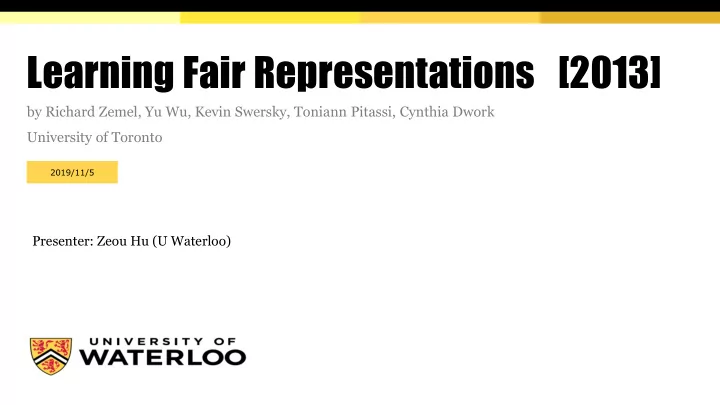

Learning Fair Representations [2013] by Richard Zemel, Yu Wu, Kevin Swersky, Toniann Pitassi, Cynthia Dwork University of Toronto 2019/11/5 Presenter: Zeou Hu (U Waterloo)
Overview ▪ Previous work ▪ This paper: the LFR Model ▪ Experiments ▪ Follow-ups ▪ Some thoughts and conclusions
Previous Work: Fairness Through Awareness [2012] Fairness Through Awareness (Dwork, Zemel et al.) proposed a framework that: • Individual fairness “Similar individuals are treated similarly” • Group fairness “Disparate Impact Parity” • Optimization problem However…… • Probabilistic mapping
Previous Work: Fairness Through Awareness [2012] Two obstacles: 1. A distance/similarity metric is assumed to be given This is problematic because: a good distance metric that defines similarity between individuals is important for ‘Individual Fairness’, but is challenging to find 2. Cannot generalize It only works for the given data set, doesn’t know what to do with future unseen data
This paper: Learning Fair Representations ( LFR model ) • Individual fairness “Similar individuals are treated similarly” • Group fairness “Disparate Impact Parity” • Optimization problem • Probabilistic mapping • Learn a (restricted form of) distance metric • Develops a learning approach that can generalize to unseen data
The LFR model in a nutshell: One sentence “We formulate fairness as an optimization problem of finding an intermediate representation of the data that best encodes the data (i.e., preserving as much information about the individual’s attributes as possible), while simultaneously obfuscates aspects of it, removing any information about membership with respect to the protected subgroup.”
The LFR model in a nutshell: Two competing goals I. the intermediate representation should encode the data as well as possible Preserve utility II.the encoded representation is sanitized in the sense that it should be blind to whether or not the individual is from the protected group Remove sensitive information
the LFR model: some notations “The main idea in our model is to map each individual, represented as a data point in a given input space, to a probability distribution in a new representation space .”
the LFR model: some MORE notations (optional)
the LFR model: probabilistic mapping Recall: “Each data point in the input space is mapped to a probability distribution in a new representation space .” How?
the LFR model: probabilistic mapping Recall: “Each data point in the input space is mapped to a probability distribution in a new representation space .” How? Actually, it’s called ‘soft - min’
Probabilistic mapping: A clustering perspective
Soft k-means
the LFR model: Objective function The objective function consists of 3 terms: 1. Fairness term (group fairness) 2. Reconstruction term 3. Utility term
Objective function: Fairness term Each cluster should contain roughly balanced “ mass ” from the protected group and the unprotected group
Objective function: Reconstruction term The learned representation should “ resemble ” the original data as good as possible
Objective function: Utility term The learned representation should still predict target variable quite well
Objective function: putting all together • Learnable parameters are: and , and (will mention later) • # of prototypes K is a hyper-parameter, in supplementary materials, they vary K ={10,20,30}, and observed that bigger K will result in better accuracy while worse fairness • The objective function is optimized using L-BFGS
the LFR model: Learning distance metric More flexible than Euclidean distance
the LFR model: what is the fairness definition? The fairness definition used in the objective function is kind of strange, but it is indeed a variant of Statistical Parity (aka Disparate Impact Parity)
Experiments It works!
Experiments Figure from: [iFair: Learning Individually Fair Data Representations for Algorithmic Decision Making]
Follow-ups There are a bunch of follow-up work on learning fair representation: • Explicitly deals with Individual Fairness [ P Lahoti et al. 2018 ] • Use neural networks (MLP,VAE etc.) to learn fair representation (the most common approach right now) [ E Creager et al. 2019 ] etc. • Adversarially fair representation [ D Madras et al. 2018 ] etc. • Inherent trade-offs in learning fair representation [ H Zhao et al. 2019 ] • And more……
Some thoughts and conclusions • The paper formulates the fairness problem in a novel way that deserves a lot of further study • Some choices of loss functions and mappings are crude, worth discussing if there are better alternatives, e.g. why using ‘L1 norm’ to compare two probability histogram? Cross -entropy seems to be a more suitable choice • This ‘prototype learning’ approach is quite unusual, nowadays most papers on learning fair representation use neural networks. Neural network approach is more flexible and compatible with the problem. The choice in this paper seems to have a historical reason. • Fair representation learning seems to be restricted to Statistical Parity only, can other definitions of fairness apply? (may not) • How to deconstruct a given classifier to determine to what extent it is fair? (Interpretability)
THANK YOU!
Recommend
More recommend